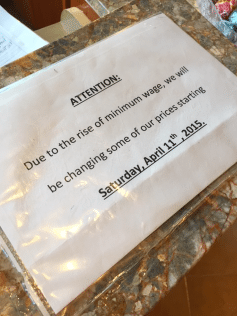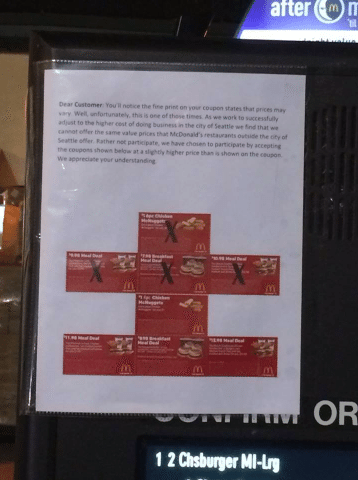The Washington Policy Center recently highlighted two examples of the consequences of Seattle’s $15 minimum wage. Check out a sign posted by a nail salon and a sign posted by a McDonald’s franchise owner in Seattle below.
The first sign reads, “Due to the rise of minimum wage, we will be changing some of our prices starting Saturday, April 11th, 2015.”
The second sign reads, “Dear Customer: You’ll notice the fine print on your coupon states that prices may vary. Well, unfortunately, this is one of those times. As we work to successfully adjust to the higher cost of doing business in the city of Seattle we find that we cannot offer the same value prices that McDonald’s restaurants outside the city of Seattle offer. Rather than not participate, we have chosen to participate by accepting the coupons shown below at a slightly higher price than is shown on the coupon. We appreciate your understanding.”
Proponents of the $15 minimum wage claim that employers can “afford to pay their workers more and will just absorb the higher labor costs.” The problem is that claim has failed to hold true to reality, i.e. employers will find ways to mitigate costs. In the case of the Seattle nail salon and McDonald’s franchise, the employers decided to pass costs to consumers. And, they are not alone. The Washington Policy Center,
“Ivar’s Salmon House is also raising prices. Ivar’s is also implementing a 17% service charge in lieu of tips. The Icon Grill in Seattle is taking a different strategy; they aren’t increasing prices, but instead eliminating three weeks of paid vacation. All employees will now only earn one week of paid vacation time; before Seattle’s new minimum wage law went into effect on April 1, some long-time employees of the restaurant received four weeks of paid vacation per year. Then there is Z Pizza—that business is closing in August, leaving 12 workers without jobs. And long-time Seattle manufacturer Cascade Designs will move 100 of its lowest-skilled manufacturing jobs from Seattle to Nevada.”
Ultimately, an artificially inflated minimum wage—especially one as high as Seattle’s $15 minimum wage—often serves to negatively impact those it seeks to benefit via unintended consequences. The Washington Policy Center,
“All of these employers are doing what they must in order to deal with a mandated wage that is higher than the value of the job. The simple fact is if the output of a job is not greater than the wage, employers must make tough decisions on how to adapt and survive. The typical result is higher prices paid by customers, along with fewer benefits and job opportunities for workers. The end result can be a double whammy for the very workers a higher minimum wage is supposed to help–workers may be earning a higher wage, but they often lose other valuable benefits and perks, not to mention the very real possibility of reduced hours and even job loss. All while paying the higher prices caused by the wage hike.”






